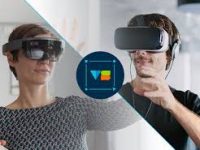What’s The Difference between Augmented Reality (AR) and Virtual Reality (VR) – Augmented Reality (AR) and Virtual Reality (VR) are two of the most talked-about technologies in recent times. While they may seem similar, there are some fundamental differences between them. In this article, we will explore the differences between AR and VR and how they are transforming the world around us.
Introduction
They both offer an immersive experience to the user, but their approach is different. AR is all about enhancing the real world, while VR is about creating an entirely new world. Both technologies have a significant impact on various industries, from entertainment to education to healthcare.

Also Read About the Advantages and disadvantages of Cloud Computing
What is Augmented Reality?
Augmented Reality (AR) is a technology that overlays digital information onto the real world. AR applications use the camera of a device, such as a smartphone or tablet, to capture the surrounding environment and then add digital elements to it. The digital elements can be anything from text to 3D objects to animations.
How Does Augmented Reality Work?
AR works by using sensors and cameras to capture the real world and then overlaying digital information onto it. AR applications use the camera of a device, such as a smartphone or tablet, to capture the surrounding environment and then add digital elements to it. The digital elements can be anything from text to 3D objects to animations.
What is Virtual Reality?
Virtual Reality (VR) is a technology that creates a completely artificial environment. VR is often associated with gaming, where users wear a headset that covers their eyes and ears, immersing them in a new world. VR can also be used for training, simulations, and therapy.
How Does Virtual Reality Work?
VR works by creating a computer-generated environment that simulates the real world. The user wears a headset that covers their eyes and ears, immersing them in a new world. The headset tracks the movement of the user’s head, adjusting the view in real-time, making it feel like they are in a completely different environment.
The Main Differences between AR and VR
The primary difference between AR and VR is the way they interact with the real world. AR enhances the real world, while VR creates an entirely new one. AR can be used to add digital information to real-world objects, while VR is used to create an entirely new environment.
AR is more accessible than VR as it only requires a smartphone or tablet. VR, on the other hand, requires a headset and a powerful computer. AR is also more social, as users can share their experiences with others in the real world. VR is more immersive, as users are completely cut off from the real world.
Applications of AR and VR
Both AR and VR have numerous applications across various industries. AR can be used for education, allowing students to interact with digital models of objects in the real world. AR can also be used for marketing, allowing businesses to create immersive experiences for their customers.
VR is often used in gaming, providing an immersive experience for players. VR can also be used for training, simulations, and therapy. In healthcare, VR is used to provide a distraction for patients during medical procedures, reducing anxiety and pain.
Conclusion
AR and VR are two technologies that are transforming the world around us. While they may seem similar, they have significant differences in their approach. AR enhances the real worlld, while VR creates an entirely new one. Both technologies have numerous applications across various industries, and their impact will continue to grow in the coming years.
FAQs
- What is the primary difference between AR and VR?
- The primary difference between AR and VR is the way they interact with the real world. AR enhances the real world, while VR creates
- Can AR be used for education?
- Yes, AR can be used for education, allowing students to interact with digital models of objects in the real world, making learning more engaging and immersive.
- How is VR used in healthcare?
- VR is used in healthcare to provide a distraction for patients during medical procedures, reducing anxiety and pain. It is also used for training and simulations.
- Is AR more accessible than VR?
- Yes, AR is more accessible than VR as it only requires a smartphone or tablet, while VR requires a headset and a powerful computer.
- How will AR and VR impact the future?
- AR and VR will have a significant impact on various industries, from entertainment to education to healthcare. They will transform the way we interact with the world and provide new opportunities for innovation and growth.




